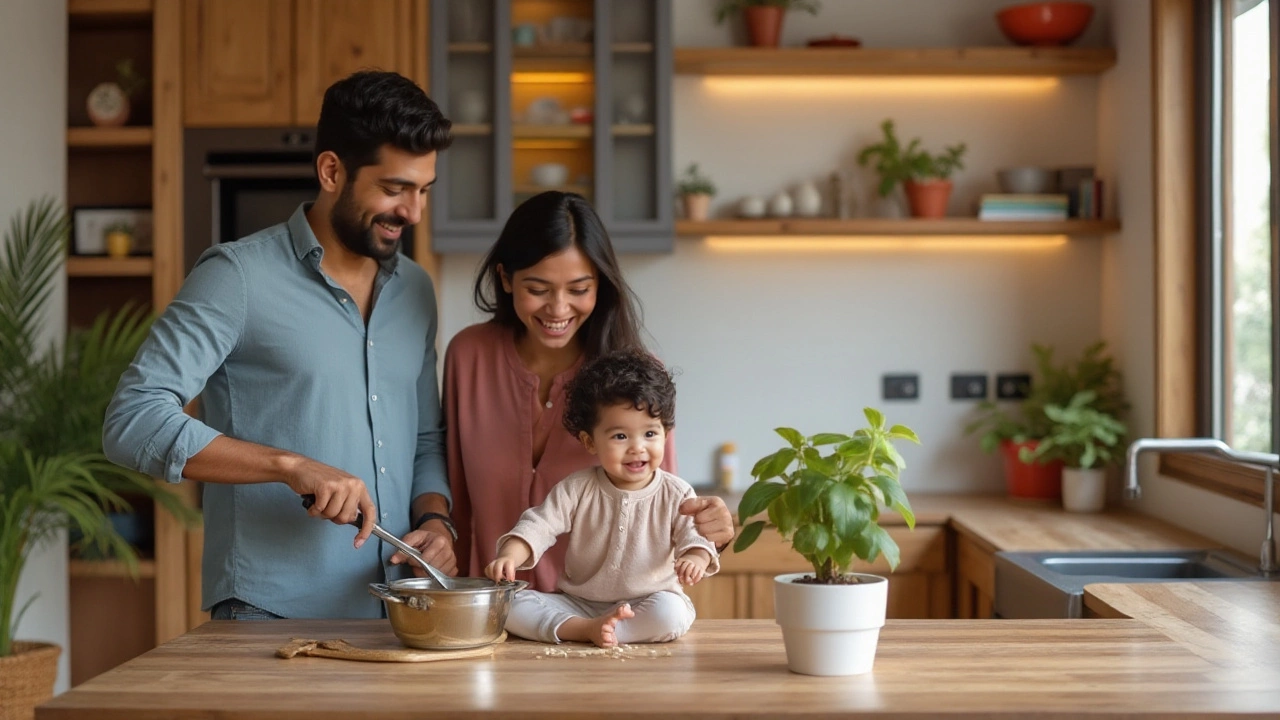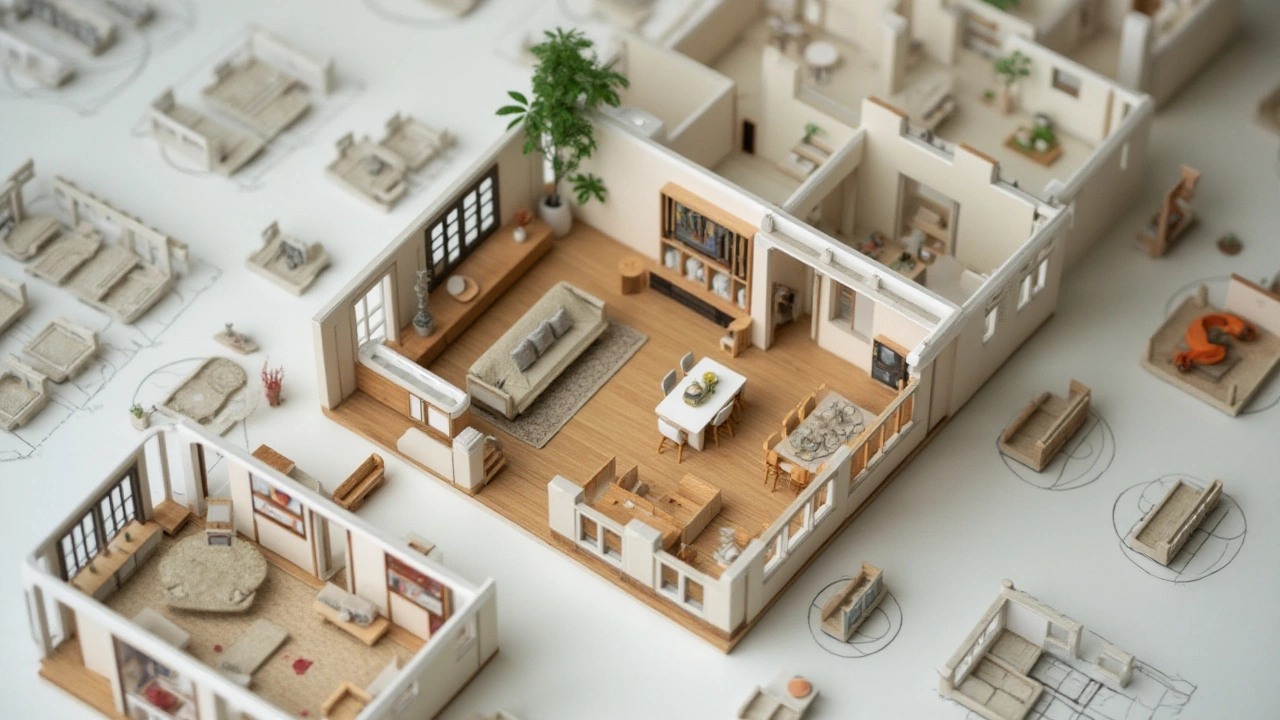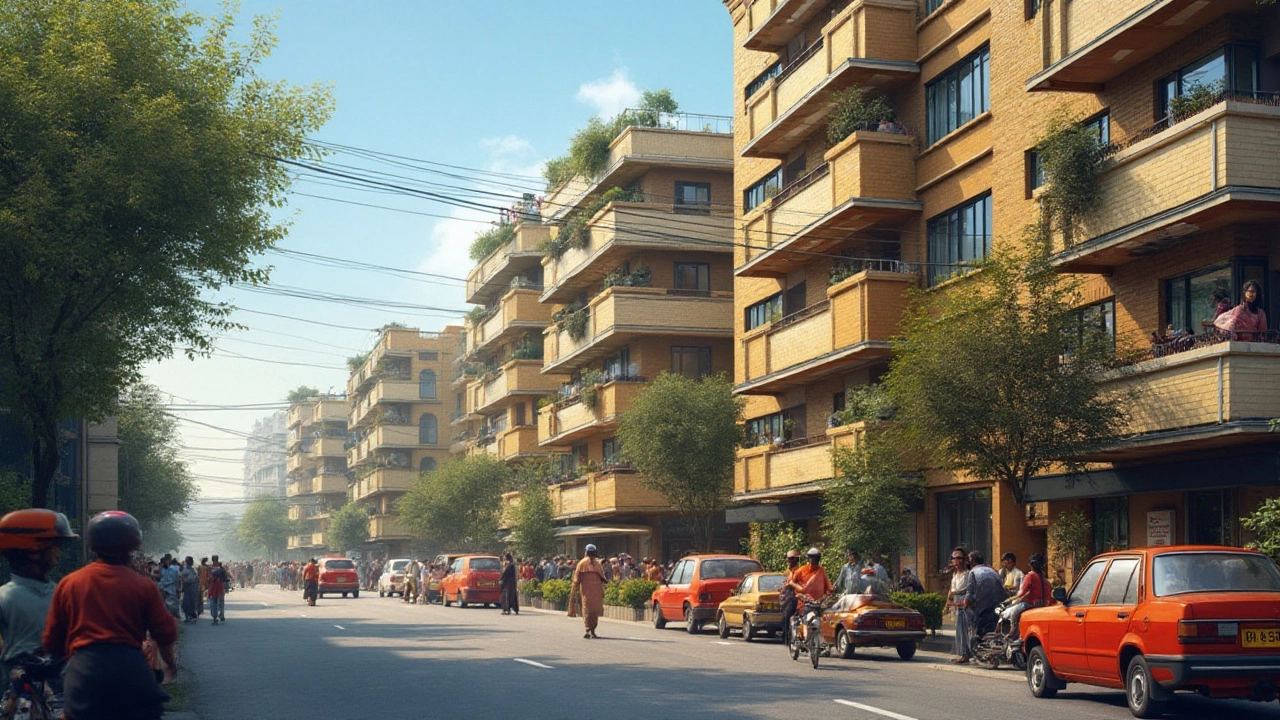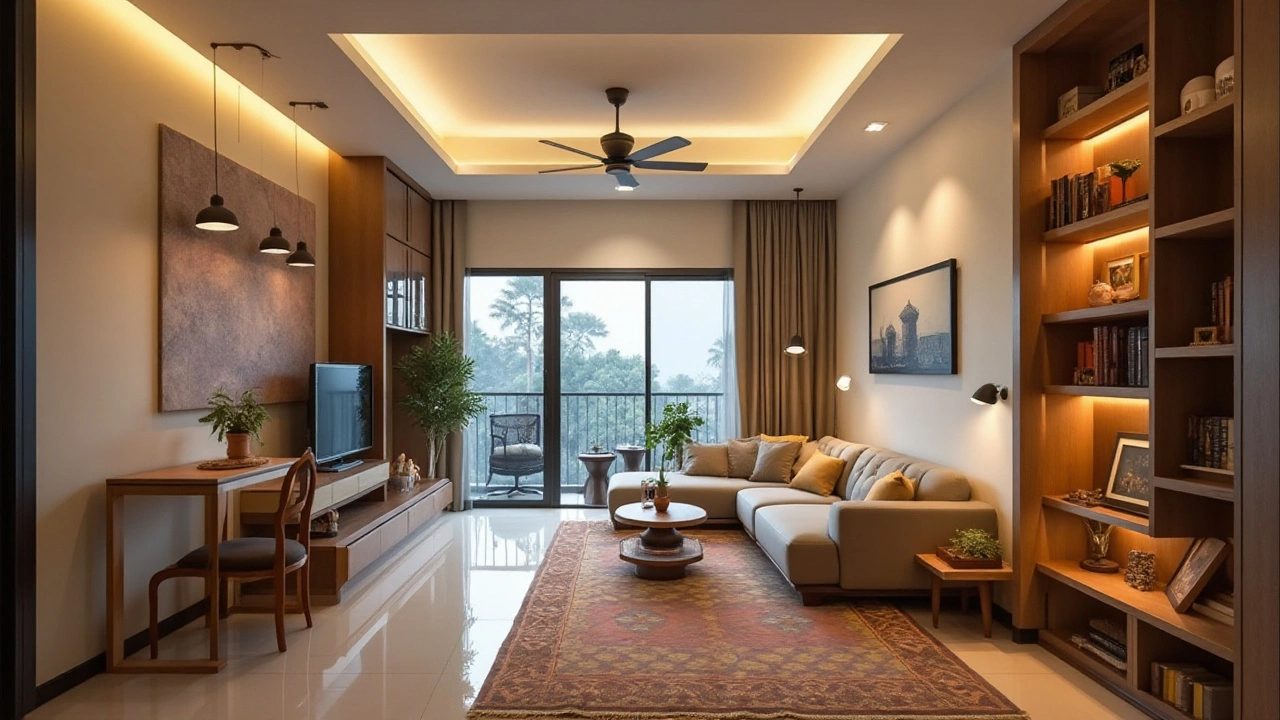Living in a 600 sq ft 2BHK apartment can spark many questions about space management and quality of life. It might seem tiny, especially if you're used to sprawling layouts. Yet, numerous people are embracing such compact spaces for their affordability and strategic location advantages. This trend speaks to the shift towards minimalistic and efficient living, ensuring every square foot matters.
Making an apartment this cozy doesn't necessarily mean sacrificing comfort. With thoughtful design choices and smart furniture, small apartments can offer an intimate yet unrestrictive living experience. Our exploration will set you on the path to deciding if this pint-sized property is the perfect place to call home.
- Understanding Compact Living
- Advantages of 600 Sq Ft Apartments
- Challenges and Considerations
- Tips for Maximizing Small Spaces
Understanding Compact Living
In recent years, there's been a noticeable shift towards compact living, driven by urbanization and a change in lifestyle preferences. As cities become more crowded, individuals and families are opting for smaller and more efficient living spaces. This trend is particularly evident in major urban areas where real estate comes at a premium. A 600 sq ft apartment, once considered too small for comfort, is now a viable option for many seeking affordability without forfeiting the convenience of city life.
Compact living goes beyond simply downsizing; it's a lifestyle choice that embraces minimalism and sustainability. People are more inclined to own fewer things, focusing on quality over quantity. The cultural shift towards minimalism is largely due to growing awareness of environmental footprints and the desire for a clutter-free space that allows residents to focus on meaningful experiences and relationships. This is not just about having less stuff; it's about finding contentment in a simplified lifestyle that encourages creative space usage and organization.
Living in small spaces requires a different mindset and design strategy. Furniture must be multipurpose, storage solutions innovative, and every element needs to be thoughtfully integrated to maintain a sense of openness. Architects and interior designers are continuously designing solutions tailored for small spaces, turning what once was a compromise into a chic and efficient living trend. In fact, some designers argue that living in a smaller space forces a person to engage with their environment meaningfully, as every piece of furniture or decor must be deliberate and functional. As Tiny House pioneer Jay Shafer once said, "People who live in tiny houses aren’t driven by the dream of having it all; they’re driven by the dream of having enough."
Moreover, compact living often appeals to younger generations who prioritize location over space. Being in the heart of a city offers access to jobs, culture, and entertainment just steps away from their doorstep. The reduced commute times, vibrant neighborhood life, and easy access to amenities and public transit often make up for the lack of square footage. Despite these perks, it's crucial to recognize the challenges that come with such an arrangement. In terms of privacy, sound insulation, and storage capacity, a 600 sq ft 2BHK apartment might require creative solutions to meet expectations.
To understand the nuance of compact living better, consider that in Tokyo, a city renowned for its efficiency and innovation, apartments averaging 500-600 sq ft are commonplace. Despite the limited space, these units are marvels of design and functionality, demonstrating that with the right approach, small living can be luxurious and aspirational. Now, data has shown that more than 20% of millennials prefer smaller apartments near city centers over larger homes in suburban areas. This statistic speaks volumes about the changing priorities and how compact living fits these evolving demands. The understanding of compact living is therefore not just restricted to space but also associated with a broader, global change reflective of modern lifestyles.

Advantages of 600 Sq Ft Apartments
Choosing a 600 sq ft 2BHK apartment may sound limiting at first, yet it offers some profound advantages worth considering. For starters, affordability is a key factor. Smaller spaces often translate to reduced costs, both in purchasing and maintaining the property. This could be particularly enticing for first-time buyers or young professionals who want to step into the property ladder without breaking the bank. Reduced utility costs come hand-in-hand with compact living as well, since there's less space to heat or cool, and lighting needs are inherently minimal.
Beyond financial benefits, there's a subtle charm in cozier living that streamlines daily life. It encourages an uncluttered lifestyle, compelling inhabitants to focus on what truly matters, both materially and spiritually. Living in a small apartment prompts mindful consumption habits, making it easier to maintain a clean and organized environment. Many find this minimalist approach liberating, allowing them to live with intention and purpose.
According to Jane Smith, the editor of "Living Small Blissfully", "A smaller living space invites creativity in design, pushing people to discover innovative solutions for storage and functionality. It's less about the space itself and more about how you use it."
Another advantage lies in the strategic locations these apartments often occupy. Urban centers are increasingly recognizing the value of high-density housing options that allow for easy access to public transport, employment hubs, and social amenities. As cities grow, compact living solutions are not purely a trend but a necessity that integrates with a walkable and sustainable urban lifestyle.
Embracing a 600 sq ft home can also mean a quicker place to tidy up and personalize without overwhelming upkeep commitments. This is particularly beneficial for those balancing demanding careers, family responsibilities, or simply preferring to spend leisure time outside rather than being tied to household chores. With lesser rooms to look after, weekend warriors can head out on adventures or dive into hobbies unburdened by the overwhelming shackles of home maintenance, finding balanced harmony between comfort and practicality.

Challenges and Considerations
Finding yourself in a 600 sq ft space can be both liberating and restricting all at once. The main challenge is space management, where every inch must serve a purpose. With such limited square footage, residents must often make tough decisions about what possessions truly matter. This inevitably encourages a shift toward minimalism. For those accustomed to having room for sprawling collections of books, clothes, or gadgets, this change can be daunting. In terms of storage, creative solutions become essential, such as utilizing vertical space with shelving or multi-functional furniture. Without the luxury of ample storage, decluttering becomes a constant endeavor, and any new acquisitions must be weighed against available space.
A significant consideration for families eyeing a 2BHK apartment of this size is privacy. While the apartment can comfortably accommodate a couple or a small family, it can become constricted as the family grows. Two bedrooms typically mean one is devoted to children, leaving adults without a private getaway. This setup can affect dynamics, making it crucial to optimize every available nook and cranny for a semblance of personal space. Noise management is another key factor; with rooms in proximity, sound often travels easily. To combat this, soundproofing solutions like rugs, curtains, and wall panels may be necessary to keep peace or enjoy some solitude.
On the plus side, the small footprint means that upkeep is usually easier compared to larger homes. However, it's still easy for clutter to build rapidly, especially when every piece of furniture, decor, and item needs to be selected with intention. This could mean visitors must be limited to prevent feeling overwhelmed by the number of people in a small room. Yet, turning a potential problem into a benefit, this size forces residents into a behavior pattern where decision-making about what comes into the home becomes more intentional. In a recent survey conducted by Small Space Living Journal, 60% of residents of such apartments expressed that their consumption habits changed positively within just six months.
Lifestyle and location often influence the degree of challenge one experiences with a small apartment. Urban dwellers, especially in bustling metropolises like New York and Tokyo, might be more accustomed to living within such confines compared to those from suburban areas. The trade-off often lies between living closer to work or leisure hotspots at a reasonable cost versus the square footage available elsewhere. As urban living trends continue, the compromise between location and space becomes a critical deciding factor for many. "Space can be a luxury, but strategic living in smaller dimensions allows expression beyond square footage," says home designer Lisa Edelman, emphasizing the growing trend towards thoughtfully curated home environments in urban enclaves.

Tips for Maximizing Small Spaces
When it comes to a 600 sq ft apartment, making the most of every inch is crucial. This space optimization begins with a clear vision of what each area should achieve, tailored to your lifestyle. Think about the rooms you use most, the activities you prioritize, and design from there. Whether it's integrating a compact dining setup or creating a nook for reading, strategic planning aids in carving out multifunctional spaces. Incorporating furniture that serves dual purposes can be a game-changer. Consider a coffee table that doubles as a workspace or a sofa bed for accommodating overnight guests. These solutions ensure you maintain a sense of openness without clutter, crucial in a small home.
Color and lighting play significant roles in enhancing the perception of space. Light colors such as soft whites or gentle pastels expand the sense of space, while a well-placed mirror can reflect light to brighten up the room. Additionally, layered lighting adds depth and warmth, from overhead fixtures to strategically placed lamps. As Kermit Baker from the Joint Center for Housing Studies at Harvard University once said,
“Lighting is not only about functionality; it shapes the aesthetic and emotional experiences within the home.”His words remind us of the importance of thoughtful lighting in creating a cozy yet spacious feeling in compact living environments.
When storage is at a premium, creativity is key. Opt for vertical storage solutions that utilize wall space rather than floor area. This might include shelves above doorways or hooks on the backs of doors. Elevated beds can make room for drawers or shelves underneath, while wall-mounted desks liberate floor space for other uses. Organizing containers and modular systems keep essentials at hand but out of sight, maintaining a tidy environment. The trick lies in consistently evaluating the necessity of items and being intentional about what you bring into your home.
The layout of a small space should prioritize movement and flow. Open-concept designs often work best in small apartments because they remove unnecessary barriers. Arranging furniture around a central point like a window or a television also optimizes utility and aesthetic appeal. Be mindful of scale; too-large furnishings will overwhelm, while too many small pieces might look cluttered. Balance is achieved when pieces serve a purpose without disrupting harmony. Investigating furniture that folds away or adjusts offers flexibility and adaptability for changing needs and guest accommodation.

